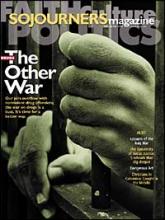AS A SCULPTOR, college professor, and Christian in the Catholic tradition, I often find myself in the position of translator between professional artists and those who might have had very little exposure to art. A number of years ago, I became involved in an interchange of letters in The Catholic Agitator, a newspaper published by the Los Angeles Catholic Worker, about a sculptural frieze encircling that city's federal building. Called “The New World” and created by sculptor Tom Otterness, the relief presents a seemingly endless queue of chubby, cartoon-like figures, struggling to lift and carry huge spheres, cylinders, and cubes. One letter-writer dubbed it "the shame of L.A.," calling it offensive and lamenting that neither the artist nor the patron had an "uplifting, aesthetic, or beautiful" image in mind.
I responded by agreeing that the image, with its Sisyphean depiction of labor based solely in the accumulation of wealth, was most certainly not uplifting or aesthetic. But I continued with a reminder that not all art is meant to convey the beautiful. One only has to look at medieval crucifixion scenes or Hieronymus Bosch's depictions of hell. In more modern times, there are Francisco Goya's etchings about the horrors of war, Picasso's painting of the bombing of Guernica, or Käthe Kollwitz's lithographs of starving children in Germany. These are all difficult artworks.
Read the Full Article
